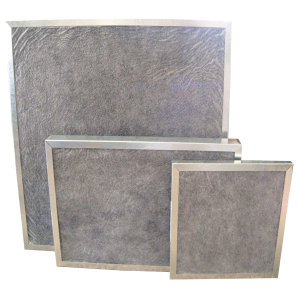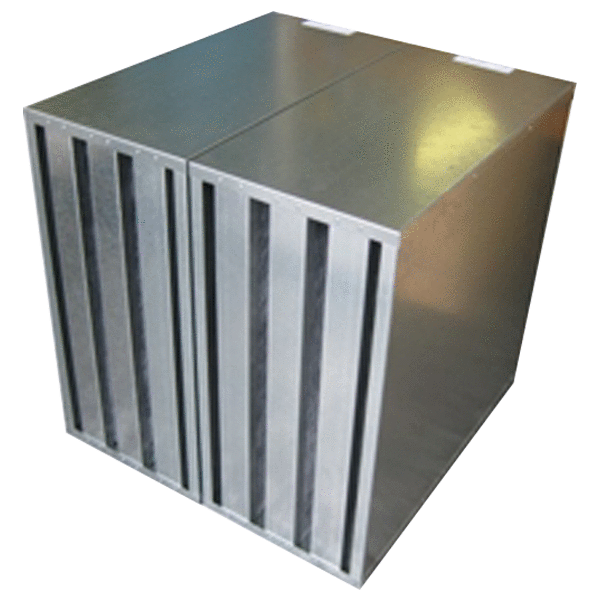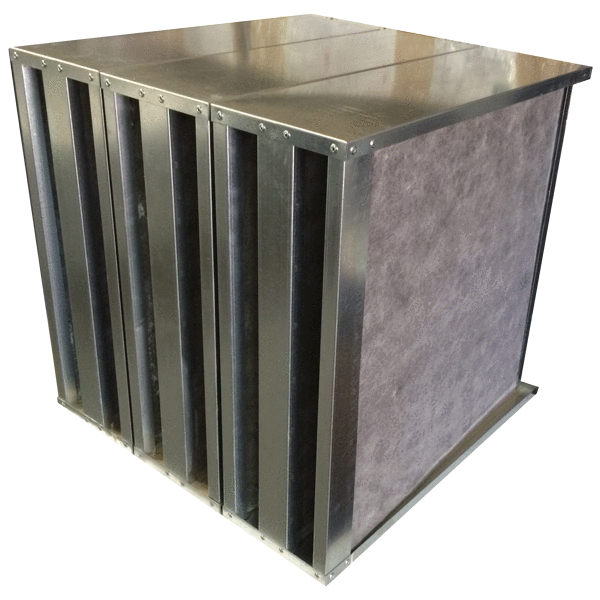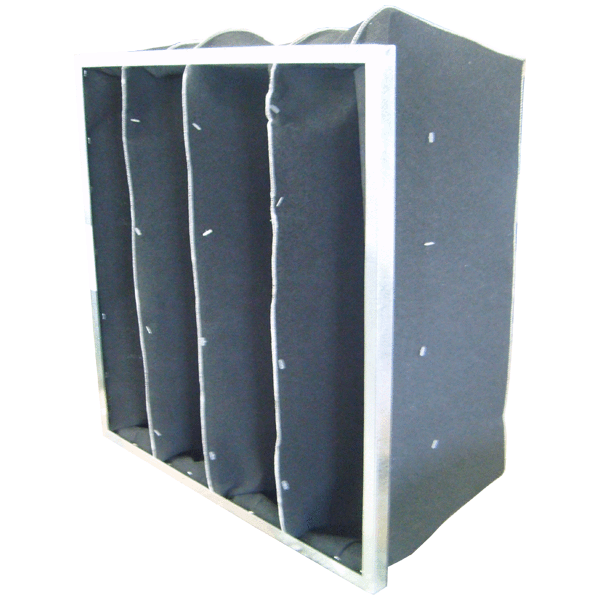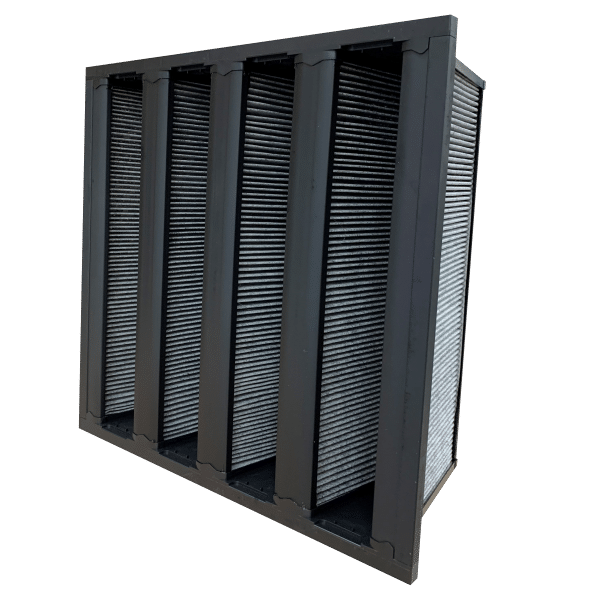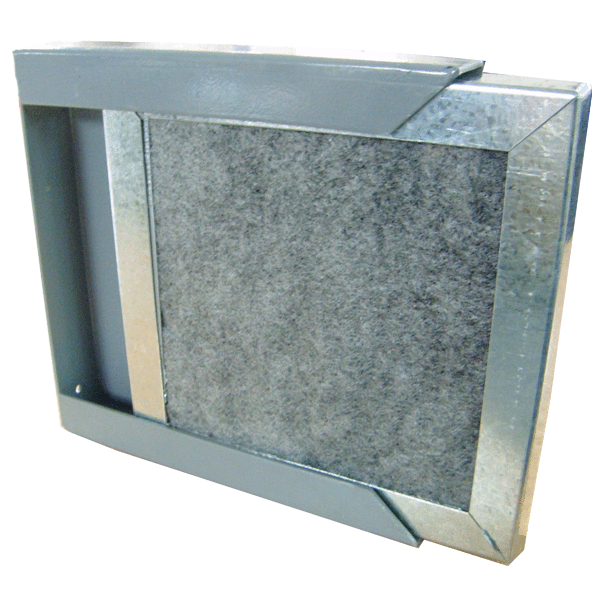Airclean Activated Carbon Filters – Panels and Discarbs
Carbon panels are normally supplied and fitted with an aluminium frame and can be made to any reasonable size to match existing panels of all makes. We impose limits on the depth of the panel to not be less than 10mm and not exceed 60mm in actual depth.
Carbon Filter Capacities
Capacities shown for Panels & Discarb units are based on a dwell time of 0.1 seconds. Which is the normally accepted minimum for most applications.
Air Flow = Width x Length x Depth/Dwell Time
or Air Flow = Width x Length x Face Velocity
As a guide,
| Nominal thickness | Actual thickness | Pressure drop | Face velocity m/s |
| 25mm | 22mm | 45 Pa | 0.22 (43fpm) |
| 22mm | 19mm | 40 Pa | 0.19(37fpm) |
We recommend a contact time of 0.3 seconds for heavier odors, such as Indian cooking odors. This will effectively reduce the face velocity and rating to one third.
Carbon Filter Temperature Limitations
If hot air is being filtered, such as the extract from cooker hoods, it’s advisable to position the carbon cells as far as possible from the heat source.
Consequently to comply with the standards, it is necessary to maintain air stream temperatures below 40°C and humidity levels below 80% RH. If the anticipated temperature or humidity exceeds either of these figures, it’s necessary to treat the airstream. Suitable measures such as additional fresh air or cooling may be considered.
Pre Filters for Activated Carbon
Pre-filters should be fitted in the ventilation system to protect the carbon filters in all installations from particulate contamination. Firstly, we do not consider a glass panel to be suitable and recommend a filter having a minimum grade of F5 to EN779.
Some cooking operations give off large amounts of smoke, which is extremely detrimental if allowed to reach the carbon filters (smoke is a particulate).
In most cases this can be overcome by the use of a good quality pre-filter. e.g. an F8 Grade Bag Filter or better, depending upon circumstances. In some instances a HEPA Filter grade H14 is necessary.
Discarb Cells can be tailor-made to any reasonable size to fit ducting, air-handling units etc.
Activated carbons are graded as follows
Grade 20 Activity Carbons are rated 30% on their ability to adsorb carbon tetra-chloride (CTC) in testing; and have a typical surface area per weight of between 700-800 m2/g by the BET N2 method (the area being a measure of the area of the walls of the cavern like structure of the activated carbon): Bulk density is between 0.55 – 0.59 g/cc
Grade 50 Activity Carbons are rated 55% on their ability to adsorb carbon tetra-chloride (CTC) in testing; have a typical surface area per weight of between 1100-1200 m2/g by the BET N2 method (the area being a measure of the area of the walls of the cavern like structure of the activated carbon): Bulk density is between 0.49 – 0.53 g/cc.
Airclean Activated Carbon Filters are generally manufactured using the bonding process to provide a rigid panel which is often called a Biscuit. The bonded carbon biscuit can be framed in a metal channel so that it can be easily slid into channel holding frames mounted into ductwork or filter housings. The panel is finished in a fabric facia which minimises the dusting from the panel.
Our Activated Carbon Panel Air Filters can also be produced using a loose fill technique, which can offer an improved rate of absorbency. Despite the improved rate of absorbency the Activated Carbon Panels capacity will remain the same The panels are designed to minimise the risk of bypass due to settlement, and for this reason their installation should be designed to be horizontal.
The metal cased Discarb cells have the highest carbon loading in our range. Additionally have standard or heavy-duty carbon panels permanently sealed into a galvanised sheet steel casing.
This construction gives a very strong unit capable of handling large air volumes or where conditions dictate, increased contact time. Furthermore advantage of this unit is that with panels sealed in, there is no possibility of air leakage.
Activated Carbon Discarb Filter Units can be manufactured to almost any reasonable size. The limiting factors being the overall weight for handling purposes and the size of individual panels. When the unit has finished its useful life it is discarded and replaced with a complete new cell.
The Activated Carbon impregnated bag filter, can be utilised to remove the slight general odours associated with towns and cities. When the filter is used in the extract systems of light duty catering establishments, such as coffee shops, the life of it will be very short, as the odour retention is directly proportional to the weight of activated carbon on the product.
Airclean will not recommend this product for new
installations for odour removal.
Rigid Bag Filters can be used in a wide variety of air conditioning and general ventilating applications. Usually where large volumes of air are to be handled and systems dictate high dust holding capacity, coupled with low initial resistance.
The Carbon Impregnated version of this filter is designed to adsorb low concentrations of odours, or gases associated with pollution. Generally these filters are used on supply ventilation systems into offices and public buildings.
Lead Time
Activated Carbon Filters are manufactured to order at our works, and generally take 7-10 working days.
It is extremely difficult to calculate in advance the life expectancy of an Activated Carbon Filter. As detailed information of contaminants are unknown and always changing.
To get a good estimation of the expected life of an Activated Carbon Filter in a Kitchen Exhaust, or other gaseous extract application, Airclean offer a free CTC Testing Service.
Either a small sample of Activated Carbon from one of the cells, or a complete panel that has been in service, can be sent to our laboratory and with a few additional details such as installation date and daily usage we can determine the likely remaining useful life of the carbon cell.






